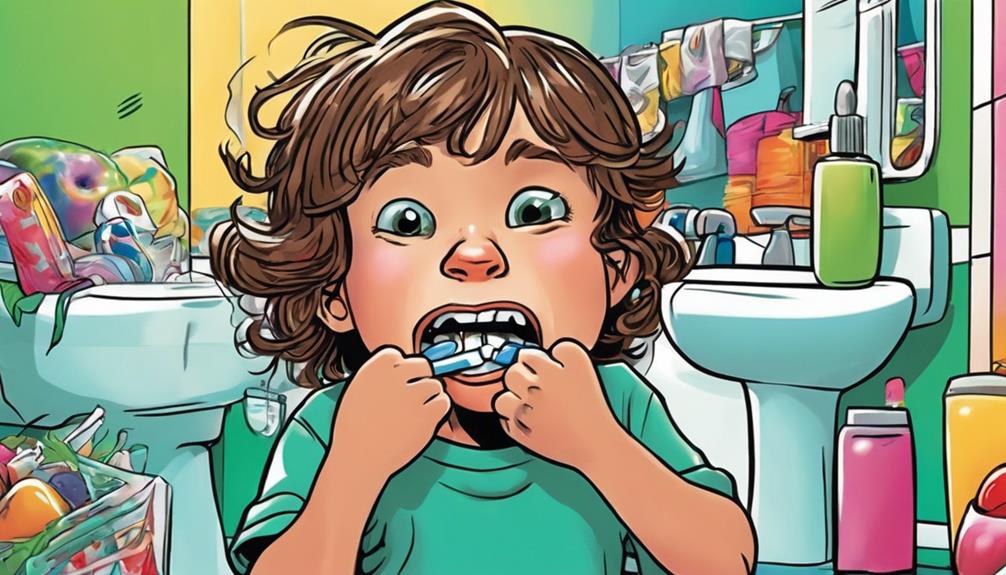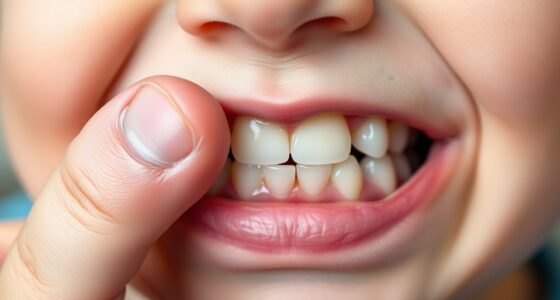If your child's breath smells bad, it could be due to several reasons. Poor oral hygiene often leads to bacteria buildup. Dry mouth, caused by dehydration or mouth breathing, can exacerbate the issue. Certain foods, like garlic and sugary snacks, also contribute to unpleasant odors. Gum disease and tongue coating are other common culprits that can trap bacteria. Additionally, health conditions and foreign objects in the nose can play a role. With the right strategies, you can improve their breath and boost their confidence. Discover more about these causes and effective solutions to tackle bad breath!
Key Takeaways
- Poor oral hygiene, such as infrequent brushing, leads to plaque buildup and bacteria, causing bad breath in children.
- Dry mouth from dehydration or mouth breathing can exacerbate bad breath; encourage hydration and nasal breathing.
- Certain foods, particularly high-sugar and pungent items, contribute to unpleasant odors; promote crunchy fruits and vegetables for better breath.
- Enlarged tonsils may trap food particles and bacteria, leading to bad breath; regular throat checks and good hygiene are essential.
Understanding Halitosis in Children
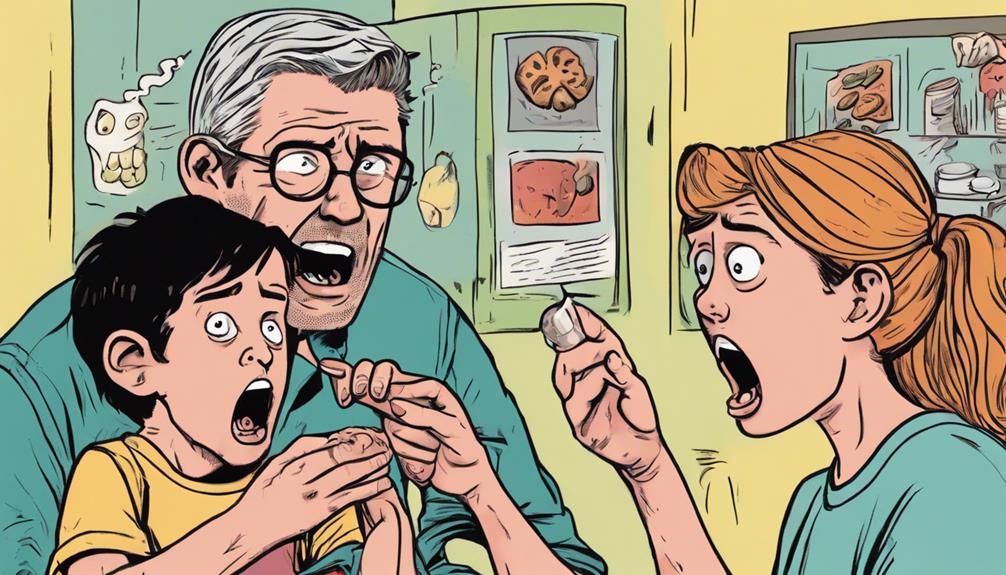
Halitosis, or chronic bad breath, often affects children due to factors like poor oral hygiene and certain foods. If your child experiences bad breath, it's crucial to identify the underlying cause.
In many cases, the accumulation of bacteria on the tongue and in the mouth plays a significant role. This bacteria thrives, especially if your child has a dry mouth, which can happen during sleep or if they aren't drinking enough water.
Certain foods can also contribute to the problem. Foods high in sulfur, like garlic and onions, can lead to temporary bad breath that lingers even after brushing. It's crucial to maintain a consistent oral hygiene routine, including regular brushing and flossing, to help minimize the effects of these foods.
Additionally, persistent bad breath in children might indicate underlying health conditions such as diabetes, gastroesophageal reflux disease (GERD), or sinus infections. If you notice your child's breath doesn't improve despite good oral hygiene, consider consulting a healthcare professional to rule out any medical issues.
Understanding these factors can help you address and manage your child's bad breath effectively.
Poor Oral Hygiene

If your child isn't brushing their teeth regularly, it can lead to bad breath caused by plaque buildup.
You should also pay attention to their tongue, as a coated tongue can trap bacteria and worsen the odor.
Establishing a consistent oral hygiene routine will help keep their breath fresh and healthy.
Importance of Regular Brushing
Regular brushing is essential for keeping your child's breath fresh and preventing the buildup of odor-causing bacteria in the mouth. Encourage your child to brush twice daily for at least two minutes. This routine not only removes plaque and food particles but also greatly reduces the risk of bad breath.
Using a fluoride toothpaste suitable for their age strengthens enamel and decreases cavity risks, which can contribute to unpleasant odors.
It's important to teach your child proper brushing techniques. Show them how to angle the toothbrush towards the gumline and make certain that all surfaces of their teeth are cleaned. This attention to detail in their oral hygiene can effectively combat halitosis.
Additionally, regular dental check-ups every six months are essential. These visits help identify and address any oral hygiene issues early, further promoting fresh breath and overall dental health.
Tongue Cleaning Techniques
Cleaning your child's tongue daily can greatly reduce the bacteria and food particles that contribute to bad breath. Implementing tongue cleaning into their oral hygiene routine can considerably improve their breath freshness and help combat halitosis.
Here are some effective techniques you can use:
- Use a Tongue Scraper: This tool removes bacteria more thoroughly than a toothbrush alone.
- Gentle Brushing: Use a soft-bristled toothbrush to gently brush from back to front.
- Rinse Regularly: Rinse the scraper or brush after each pass to avoid redistributing bacteria.
Dietary Influences

Diet plays an essential role in your child's breath, with certain foods either worsening or improving the situation. Consuming pungent foods like garlic and onions can lead to lingering odors due to sulfur compounds. Similarly, a diet high in sugary and starchy foods can encourage the growth of bacteria in the mouth, which generates odorous volatile sulfur compounds.
To combat bad breath, encourage your child to munch on crunchy fruits and vegetables such as apples and carrots. These foods help clean teeth and stimulate saliva production, which is beneficial for fresh breath. Dairy products like yogurt and cheese can also be effective; they neutralize acids in the mouth and reduce odor-causing bacteria.
Don't forget the importance of hydration. Ensuring your child drinks plenty of water throughout the day helps wash away food particles and bacteria, preventing dry mouth—a common contributor to halitosis.
Physiological Factors
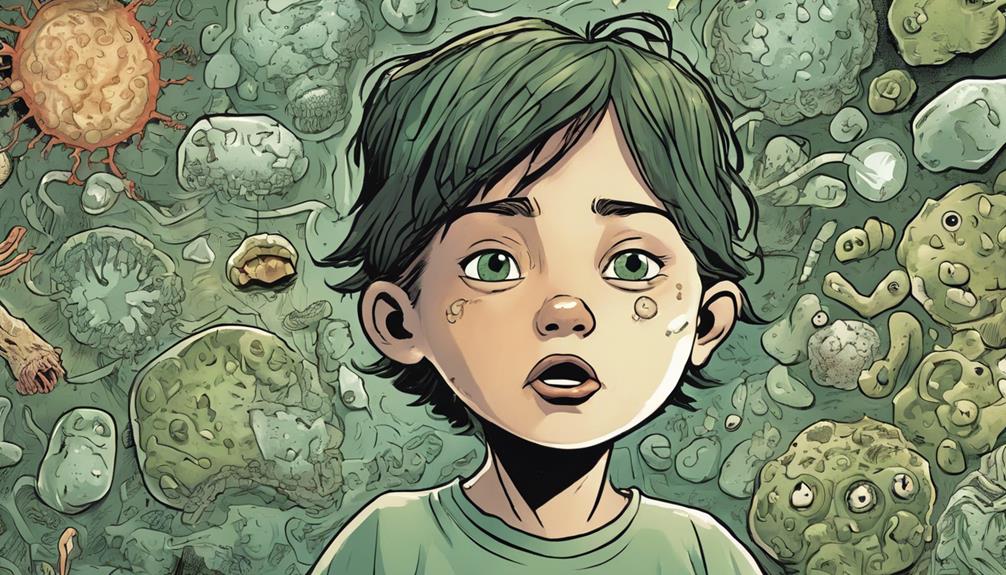
When it comes to your child's bad breath, physiological factors can play a significant role.
Conditions like dry mouth, enlarged tonsils, and certain health issues can all contribute to unpleasant odors.
Understanding these factors can help you identify potential solutions to improve your child's breath.
Dry Mouth Causes
Dry mouth, or xerostomia, can stem from various physiological factors, including dehydration, certain medications, and underlying medical conditions. When saliva production decreases, it creates an environment where bacteria can thrive, leading to halitosis.
Here are some common causes of dry mouth in children:
- Dehydration: Not drinking enough fluids can greatly reduce saliva production.
- Medications: Some medications, like antihistamines, can contribute to dry mouth.
- Medical Conditions: Conditions such as diabetes or Sjögren's syndrome can affect saliva glands.
Saliva plays an essential role in keeping your child's mouth healthy by washing away food particles and bacteria. Without enough saliva, the risk of halitosis increases.
To help combat dry mouth, encourage your child to stay hydrated and consider using saliva-stimulating products like sugarless gum. Addressing these factors can greatly improve your child's breath and overall oral health.
Tonsil Issues
If your child has persistent bad breath despite good oral hygiene, tonsil issues might be the underlying cause. Enlarged tonsils can trap food particles and bacteria, leading to the formation of tonsil stones, which often contribute to halitosis.
Additionally, tonsil infections or inflammation caused by viruses or bacteria can worsen bad breath due to the release of foul-smelling gases from the infected tissue.
You should also consider post-nasal drip from allergies or sinus infections, as this can result in mucus accumulation at the back of the throat, feeding bacteria and causing even more bad breath. Regular throat checks are essential; if you notice your child has large tonsils, they might harbor bacteria that produce unpleasant odors. If tonsil stones are present, medical attention may be needed.
To help alleviate bad breath associated with tonsil issues, encourage your child to maintain good oral hygiene. This includes brushing their tongue and gargling with salt water, which can help reduce bacteria and improve breath freshness.
Addressing tonsil problems early can greatly improve your child's breath and overall well-being.
Health Conditions Impact
Several health conditions can greatly impact your child's breath, leading to various unpleasant odors that may require attention. Some common health conditions that can contribute to bad breath in children include sinus infections, dental problems, and tonsillitis. It is important to address these underlying issues in order to effectively defeat bad breath. By seeking proper medical treatment and practicing good oral hygiene, parents can help their children manage and eliminate unpleasant odors in their breath.
It's important to recognize the potential medical conditions that might be causing bad breath, as they can signal underlying issues. Here are some common causes of bad breath to watch for:
- Diabetes: A sweet or fruity odor may indicate insufficient insulin production.
- GERD: Sour-smelling breath can result from stomach acids regurgitating into the mouth.
- Enlarged tonsils: These can trap food particles and bacteria, leading to persistent bad breath, particularly with tonsil stones.
If you notice any of these symptoms, it's crucial to consult with your child's pediatrician.
Conditions like liver or kidney disease can also produce distinct breath odors, necessitating further evaluation.
Addressing these health conditions promptly can help improve your child's overall hygiene and well-being.
Don't hesitate to seek professional advice if your child's breath smells unusual; it could be a sign that something needs attention.
Health-Related Conditions
Health-related conditions can greatly contribute to a child's bad breath, making it vital to identify the underlying causes for effective treatment.
For instance, oral thrush, a fungal infection, can lead to a foul odor in your child's mouth, particularly if their immune system is weakened or if they're on antibiotics. If you notice a persistent bad smell, it's worth checking for this condition.
Another common issue is gastroesophageal reflux disease (GERD). This condition allows stomach acids to enter the mouth, resulting in a sour or acidic breath. If your child frequently complains of heartburn or has an unusual taste in their mouth, GERD might be the culprit.
Additionally, chronic conditions like diabetes can cause sweet or fruity-smelling breath due to elevated ketone levels, signaling a need for medical evaluation.
On rarer occasions, liver disease can produce a foul breath odor known as 'fetor hepaticus,' while kidney disease may lead to a smell resembling urine or ammonia. If you notice any of these symptoms, it's imperative to consult a healthcare professional promptly.
Mouth Breathing

Mouth breathing, often caused by nasal congestion or allergies, can greatly contribute to your child's bad breath. When kids breathe through their mouths, it can lead to dry mouth, which decreases saliva production. Saliva plays an essential role in washing away odor-causing bacteria and food particles.
Here are some factors to take into account regarding mouth breathing:
- Nasal congestion: This can make it difficult for children to breathe through their noses.
- Allergies: Allergies may also contribute to nasal blockage and habitual mouth breathing.
- Dry mouth: It creates an environment for odor-producing bacteria to thrive.
To help improve your child's breath, monitor for signs of nasal congestion. If allergies or structural issues seem to be at play, it might be time to consult a healthcare provider.
Encourage your child to breathe through their nose, especially during sleep. This simple change can help maintain moisture in the mouth and reduce bad breath associated with dry mouth. Taking these steps can make a significant difference in your child's oral health and confidence.
Foreign Objects in the Nose

If your child has bad breath, it might be due to a foreign object stuck in their nose.
Keep an eye out for symptoms like foul-smelling discharge or nasal congestion, as these can indicate a problem.
If you suspect something's lodged up there, don't hesitate to seek medical help to avoid further complications.
Common Foreign Objects
Children often stick foreign objects up their noses, leading to bad breath caused by bacteria and mucus buildup around the item. When this happens, the accumulation can create a foul smell and nasal discharge, making it vital to identify and remove the object quickly.
Here are some common items kids tend to insert into their nostrils:
- Small toys
- Beads
- Food particles
These foreign objects can cause inflammation and even infection if left untreated. If you suspect your child has inserted something into their nose, keep an eye out for signs like a persistent foul smell or difficulty breathing through one nostril.
It's essential to address the situation promptly by seeking medical attention. Regularly monitoring your child during playtime can help prevent these incidents, reducing the risk of associated bad breath.
Symptoms to Watch For
What signs should you look for to determine if your child might have a foreign object lodged in their nose?
First, pay attention to any unusual bad breath. If your child has foul-smelling breath along with nasal inflammation or a runny nose, it could indicate a foreign object stuck in their nostril. This situation can lead to bacterial growth, resulting in unpleasant odors.
You might also notice discomfort or swelling around the affected nostril. A visible obstruction is another significant symptom. Additionally, a foreign object can cause postnasal drip, which contributes to bad breath as mucus builds up and creates an ideal environment for bacteria.
Monitor your child's behavior closely. If they seem to be frequently touching or rubbing their nose, it could signal discomfort from a foreign object. Persistent bad breath combined with these unusual nasal symptoms is a strong indicator that you should seek medical attention.
It's essential not to attempt to remove the object yourself, as this can lead to injury or worsen the situation. Instead, consult a medical professional for proper evaluation and care.
Seeking Medical Assistance
Seeking medical assistance is essential when you suspect your child has a foreign object lodged in their nose, as timely intervention can prevent complications and restore comfort. Ignoring the situation may lead to nasal inflammation, infections, or even respiratory issues.
Here are some signs that indicate it's time for a medical evaluation:
- Persistent bad breath
- Runny nose or nasal discharge
- Visible discomfort or irritation around the nose
If your child shows any of these symptoms, it's important to act quickly. Medical professionals can conduct a thorough examination and safely remove the foreign objects, alleviating the associated symptoms and restoring normal nasal function.
Remember, monitoring young children during play is key to preventing them from inserting small items into their nostrils. Don't hesitate—seeking prompt medical evaluation not only helps address the immediate issue but also minimizes the risk of further health complications.
Your child's well-being is worth it, so trust your instincts and get them the help they need.
Tongue Coating
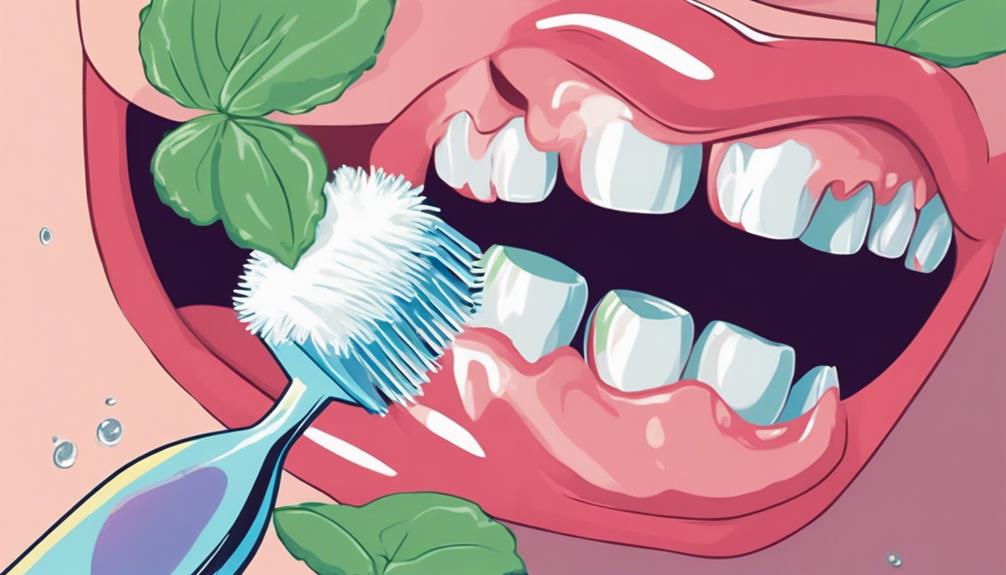
A coated tongue, often appearing white, can be a notable contributor to your child's bad breath due to the buildup of bacteria, food particles, and dead cells. This tongue coating can indicate poor oral hygiene, which plays a vital role in keeping breath fresh. If you notice a white coating on your child's tongue, it's important to address it promptly.
Regular tongue cleaning can make a considerable difference. Encourage your child to brush their tongue or use a tongue scraper daily. These practices can markedly reduce odor-causing bacteria, helping to combat bad breath. Remember, studies show that about 50% of bad breath cases are linked to a coated tongue, emphasizing the significance of this simple step in oral hygiene.
Additionally, dry mouth can worsen tongue coating, as saliva helps cleanse the mouth and neutralize odors. Make certain your child stays hydrated and consider incorporating crunchy fruits and vegetables into their diet, as these can help naturally clean the tongue.
Gum Disease
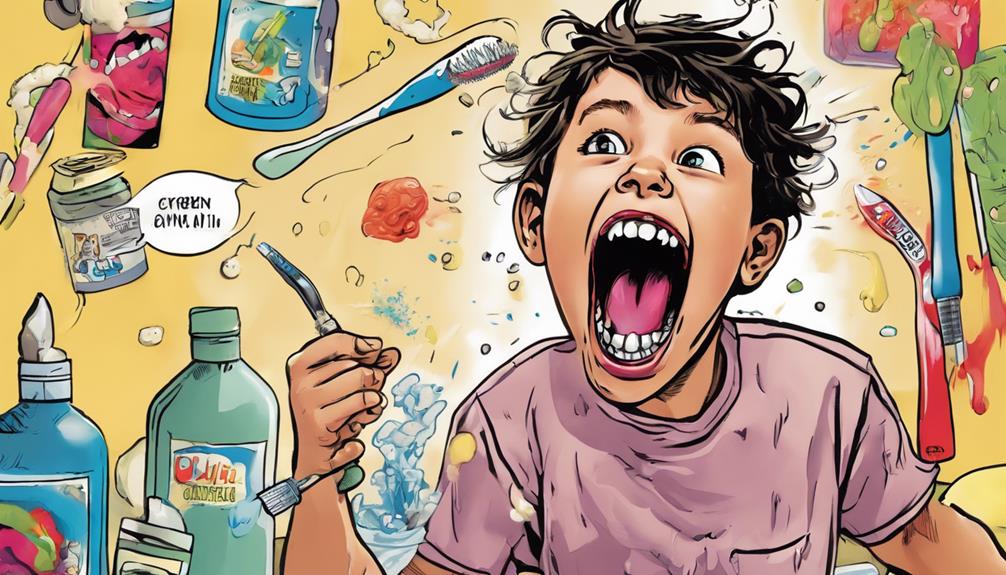
Gum disease, especially gingivitis, can greatly contribute to your child's bad breath by causing swollen, infected gums that release foul odors. This common condition often arises from plaque and tartar buildup, making it important to maintain good oral hygiene.
Look out for these early signs of gum disease in your child:
- Red, swollen gums
- Bleeding during brushing
- Persistent bad breath, even with regular brushing
If left untreated, gum disease can worsen and progress to periodontitis, leading to more severe symptoms and even tooth loss. It's essential to address these symptoms early on. Regular dental check-ups can help detect gum disease before it becomes a bigger issue.
Pediatric dentists provide professional cleanings and valuable education on effective brushing and flossing techniques that promote better oral hygiene.
Encouraging your child to brush twice daily and floss regularly is important for preventing gum disease and the bad breath that comes with it. By being proactive, you can help guarantee your child's smile remains healthy and fresh!
Recommended Solutions

To combat your child's bad breath effectively, focus on establishing a consistent oral hygiene routine that includes brushing, flossing, and regular dental visits. Encourage your child to brush their teeth twice daily for at least two minutes, making sure they clean their tongue, too. Schedule regular dental check-ups every six months to catch any dental issues early, as they can contribute to bad breath.
In addition to a solid oral care routine, consider these bad breath remedies:
| Solution | Benefit |
|---|---|
| Drink plenty of water | Washes away food particles and bacteria |
| Chew sugarless gum | Stimulates saliva production |
| Eat crunchy fruits and veggies | Naturally cleans teeth and freshens breath |
Educate your child on the importance of a balanced diet. Limiting sugary and strong-smelling foods can help maintain fresh breath. By implementing these practices, you'll not only improve your child's oral health but also boost their confidence with fresh breath daily.
Frequently Asked Questions
How to Treat a Child's Bad Breath?
To treat your child's bad breath, guarantee they brush twice daily, floss regularly, and stay hydrated. Encourage tongue cleaning, limit strong-smelling foods, and schedule dental check-ups to address any underlying issues.
Why Does My Child's Breath Stink Even After Brushing?
Your child's breath might still stink after brushing because bacteria can linger on the tongue, dry mouth may occur, or certain foods could be affecting their breath. Regular dental check-ups are essential for addressing underlying issues.
How Do You Fix Stinky Breath?
Think of your child's mouth as a garden; water it daily. Encourage brushing, tongue cleaning, and regular dental visits. Limit strong foods, and let them chew sugarless gum to nurture fresh breath.
What Drink Kills Bad Breath?
To kill bad breath, drink plenty of water to flush away bacteria. Green tea's polyphenols can inhibit bacteria growth, while milk neutralizes odors from foods. Sugar-free drinks with xylitol also stimulate saliva, helping freshen your breath.
Conclusion
In summary, tackling your child's bad breath might feel like starting on an epic quest, but fear not!
By addressing poor oral hygiene, diet, and potential health issues, you can transform their breath from a dragon's fiery exhale into a sweet breeze of freshness.
Regular dental visits, tongue cleaning, and mindful eating can work wonders.
So, arm yourself with knowledge and take action—because no child deserves to be known as the “kid with the stinky breath!”
